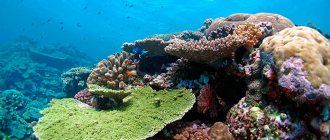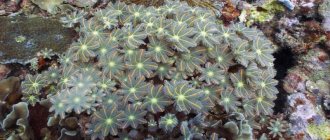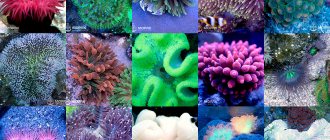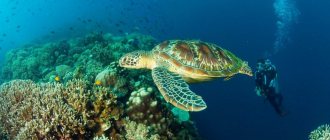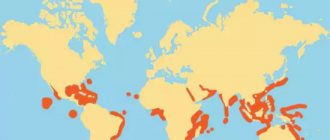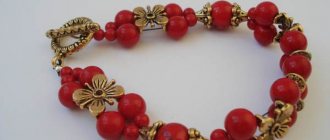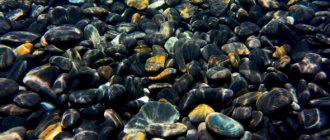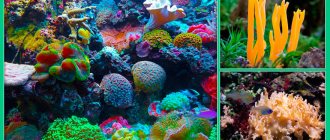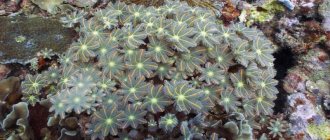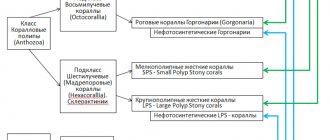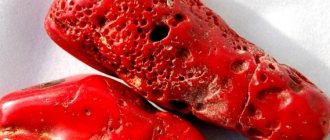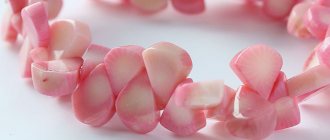Coral reefs
If you have ever dived into the depths of the sea and seen swaying corals with bizarre shapes and bright colors, you most likely thought that they were seaweed. And this is not at all surprising. It’s enough to see what these sea inhabitants look like.
Many look like beautiful bushes with many branches growing upward year after year like trees. Some look like unique flowers that cannot be found in gardens and fields.
That is why even scientists for a long time could not determine what type of living organisms to classify such beauty. It was only in 1827 that the French researcher Peysonnel for the first time convincingly proved that corals are not marine plants. So what or who is it then?
Will I surprise you by emphatically declaring that coral reefs are made of tiny animals called polyps?! This is a class of coelenterate invertebrates that can live in colonies or alone. In total, today there are about 6,000 species.
Lower multicellular animals were among the first to appear in ancient times. They have only one cavity - the intestinal cavity, in which food is digested. That's why they are called so - coelenterates.
A baby polyp can grow in length from a millimeter to several centimeters. But there are also exceptions. Thus, representatives of the madrepore species reach sizes of half a meter in diameter.
Numerous small organisms form a large whole, which in appearance often resembles a bush growing on the seabed and attracting our attention.
Do you know that? Off the northeast coast of Australia is the longest coral reef of 2,500 kilometers. It's called the Great Barrier Reef. The natural site, visible even from space, is about 8,000 years old and is under the protection of UNESCO.
Types of coral polyps
The phylum Coelenterates, in the animal kingdom, is divided into the classes Coral polyps, Scyphoids and Hydroids.
Coral polyps are represented by three subclasses: eight-rayed corals, six-rayed and trumpet anemones or ceriantharia.
Subclass six-rayed or hexacorallia
In representatives of the order helioporacea, the number of tentacles is necessarily divided by 6. There are no additional processes, but there are many branches. Sometimes five, eight or 10-rayed polyps are found. Therefore, 6-rayed plants grow in bizarre shapes in groups or settle one by one.
Thanks to their calcareous external skeleton, these polyps are the main reef builders.
The group is represented by 4-4.5 species, which includes:
Sea anemones or sea anemones actiniaria
Single polyps, up to 10 cm long, without an exoskeleton. Able to move.
Zoantharia zoanthidea
They are otherwise called cortical polyps. Usually these are tropical species, with a diameter of no more than 2 cm if they live in a colony. Singles have larger sizes. Zoantharians are also permanent residents of the reef.
Scleractinian madrepore corals or scleractinia stony corals
They live alone or in colonies. The calcareous skeleton is quite developed. Lonely Madrepores settle at depth and grow up to half a meter in diameter.
Corallimorpharia corallimorpharia
Solitary species, similar to sea anemones due to the lack of a hard skeleton. They are distinguished by their stockiness and size - the diameter of the polyp is 100 cm. The shape of the short tentacles is club-shaped.
Black corals or antipatharia
This colonial coral is used to make expensive jewelry, so the species is considered rare and endangered. It is distinguished by an internal hard skeleton, thanks to which it grows up to 6 m.
Subclass eight-rayed corals alcyonaria or mesanteria octocorallia or alcyonaria
These are small, 2 cm multi-colored polyps that live in colonies. There are 8 tentacles around the animal’s mouth. There is no formed skeleton - these are hard needles in the inner layer.
Order alcyonaria or soft corals alcyonacea
This group includes symbiotic polyps without a hard skeleton, inhabitants of the Japanese and Mediterranean seas. They settle in colonies that form trunks and branches similar to a fan, between which fish live.
Subclass trumpet anemones or ceriantharia
Anemones are single large coral polyps. These are burrowing animals that can be detected by their tentacles and mouth. They form tubes with a diameter of 1 m from intertwined discarded threads, where they settle.
Food particles are captured by numerous tentacles arranged in two corollas.
How do coral animals work?
These bottom microorganisms were created quite primitively.
The body of a coral polyp resembles a cylinder with tentacles at the end. Some polyps have a skeleton made of calcium. As a rule, they are motionless and do not move along the seabed, limited only by the bends and movements of the tentacles. But they know how to eat! After all, since they are animals, it means they must eat in order to grow.
What do you think the little bottom dwellers eat? The coral polyp's daily menu includes plankton and algae, and larger representatives may even have shrimp and small fish in their diet.
To eat food, these animals have a mouth hidden between the tentacles. In the intestinal cavity of the polyp there are cilia, thanks to which the animal lives. They create a water flow with which food and oxygen enter the small organism and waste is thrown out.
Corals that live alone have a sole with which they are attached to the seabed and with its help they can even move. Coral polyps living in a colony are united by a common body with the lower ends of the intestinal cavities.
Healing and magical properties of corals
Photo: agetrail.com
Corals have strong protective properties, and in order to ward off witchcraft spells, they must be worn in plain sight. The fashion for coral beads came to us from the Mayan Indians, who wore them as a talisman against evil forces. It was believed that if a stone broke or cracked, the magical spirit left it.
The ancient Greeks attributed the ability to bestow immortality to pink corals. They were considered the blood of jellyfish collected by sea nymphs. In many cultures, red corals were the guardians of family happiness. In Rus', coral was considered a magical stone, as well as a symbol of wisdom and modesty.
Coral also has a lot of medicinal properties. Traditional healers prescribed iodine-rich coral, ground into powder, to patients with thyroid dysfunction. It was also a popular remedy for healing stomach and intestinal ulcers. Due to its high calcium content, coral powder was widely used to treat fractures and bone diseases.
Advertising - Continued below
It is especially noteworthy that even modern medicine confirms that calcium, iodine and other minerals that make up coral are easily and effectively absorbed by the human body.
Place of residence and lifestyle of corals
Where do amazingly beautiful animals live? Most of them choose the warm tropical sea, in which the water does not cool below +20 degrees. The depth where corals live is no more than 20 meters, because this is where a lot of plankton live - food for polyps.
In addition to warm water and shallow water, corals really need sunlight, so to see all the diversity of these animals you need to go to the equator. Of course, there are also lovers of great depth and those who are not afraid of frost. Thus, bathypates climbs to the seabed at 8000 meters, and among the cold-resistant representatives is such a species as hersemia.
Corals grow very slowly: only 1 to 3 centimeters per year. Therefore, it takes hundreds and thousands of years for reefs or entire coral islands - atolls - to form on the seabed.
When coral dies, it turns into hard rock. The fossilized polyp serves as a place for new animals to grow.
Do you know that? Coral requires salt water. Even the slightest ingress of fresh water into the habitat of coral polyps is destructive for them.
The meaning of corals
Colonies of polyps, growing, form reefs, the basis of which are dead madrepore individuals. Algae containing lime is added to them. Crayfish and mollusks help build reefs.
The structure may die if the salt concentration in the water decreases, because madrepore polyps need salt. Because of the dead polyps, the environment is poisoned and the inhabitants of the reef are dying.
Role in nature
The reef maintains the ecological and climatic balance of the planet due to the concentration of carbonates and carbon. Atmospheric carbon dioxide and carbon dissolved in the waters of the World Ocean, their ratio is the regulator of the Earth’s temperature regime. If the corals die, the water's carbon concentration will increase and the climate will change.
Coral reefs are sensitive to polluted water.
Using fossil reefs, scientists have determined that the Earth's rotation used to be faster, so the year lasted 5 days longer.
Coral reefs are home to 25% of marine life and are the most biologically active place to support marine species.
The most famous “coral giant” is located near Australia and is called the Great Barrier Reef, 2500 km long.
Human use
The fringing reef forms an atoll suitable for human, animal and plant life. One of the famous atolls where people live is Bikini Atoll, in the USA.
Man makes jewelry from corals, rare black corals are especially valued, obtains lime, and uses them for construction. Aquarium lovers add brightly colored coral polyps to their fish.
Tourists who come to admire the coral reefs or go diving help support the economy of the reef's host country. The reef itself is protection in the path of a hurricane or tsunami.
What types of corals are there?
Among the coral kingdom, there are some main species:
- madreporaceae with a stony skeleton;
- alcyonaria - soft corals;
- gorgonians - fan-shaped horn corals;
- sea feathers;
- spongy, with large pores.
In addition, they are divided into six- and eight-rayed.
The color range of coral animals is striking in its palette. Red and brown colonies are most often found on the seabed. Orange corals appear a little less often in nature, but it is much more difficult to see a black, green or pink colony. In addition, not every diving expert has observed purple or bright yellow polyps on the seabed.
Red animals are called “blood foam” or “blood flower”, and black ones are called “royal”.
Physicochemical properties of coral
The basis of coral is calcium carbonate with various impurities and, in the scientific sense, it is not a stone at all. Depending on the species, coral can contain different amounts of organic substances, and the more there are, the darker its color will be. Indian black coral is almost 100% organic; it is listed in the Red Book and its industrial mining is prohibited.
Untreated corals have a matte sheen and are quite sensitive to high temperatures and chemical influences. The most common colors are pale pink, peach and red-orange, but blue corals are also the rarest and most valuable.
Advertising - Continued below
In the jewelry industry, the cost of natural coral is quite high and depends on the uniformity of color, the absence of any defects, stains and cracks.
Features of the structure and development of corals
All coelenterates (phylum Coelenterata, otherwise Cnidaria) are almost exclusively marine animals with radiant symmetry of the body, with one internal cavity, which also opens with one hole. Their body wall consists of an outer layer (ectoderm) and an inner layer (endoderm), between which there is a layer of structureless so-called mesoglea. The ectoderm contains stinging cells (cnidoblasts), which, when necessary for protection from predators or, conversely, when attacking the smallest crustaceans, ciliates, etc., that serve them as food, contract and emit a thread with a poisonous liquid (hence the second name of this type Cnidaria , i.e. cnidarians). The following three classes are distinguished among the coelenterates:
- Hydroid polyps (Hydrozoa; these include our freshwater hydra). Solitary and colonial animals, individual individuals of which can have the form of both a polyp and a jellyfish, with a pseudochitinous or calcareous skeleton. Known since the Cambrian, and possibly from the Precambrian, they still exist today.
- Scyphozoa. These are jellyfish with a thick gelatinous layer, imprints of which in rocks have also been found since the Cambrian, and possibly from the late Precambrian.
- Coral polyps, or simply corals (Anthozoa), most of which are characterized by the presence of a skeleton composed of aragonite or calcite fibers. Their most reliable representatives are known from the Ordovician, but they may have appeared earlier.
Paleontology does not have the organisms themselves, but their remains, which can be preserved in a fossil state - fossilized skeletons, prints, casts, cores. In this regard, corals are a very valuable object for paleontological research, since most of them have always formed a strong skeleton. Actually corals
- exclusively marine animals. They can be solitary or colonial. The body of each polyp (zooid) looks like a sac with a slit-like opening - a mouth, which is surrounded by tentacles. A short, flattened pharynx extends from the mouth into the internal cavity. The internal cavity itself is divided by vertical partitions (mesenteries) that are not connected to each other in the center of the cavity. The wall, like that of all other coelenterates, is three-layered. In the fossil state, imprints of the soft parts of the body of corals are extremely rare. In this regard, the discovery made by the Canadian paleontologist P. Copper (Copper, 1985) is unique. In Silurian deposits, which are about 430 million years old, he discovered fossilized coral polyps replaced by rock - favositides with perfectly preserved tentacles - from 11 to 13, but most specimens have 12. How could it happen that such delicate small ones were so well preserved polyps? P. Copper suggested that perhaps these corals adapted to life in conditions of super-hard water, i.e., in fact, during the process of life they simply seemed to be filled with mineral matter, which was preserved, passing on to us both the shape and general features structure of polyps. However, this is unlikely, since, as numerous analyzes have shown, in such water, which is more than oversaturated with mineral salts (primarily lime), not a single organism can exist. It is more obvious that such corals lived in normal conditions favorable to them, but the sudden introduction of a huge amount of minerals into this area of the sea basin (perhaps even from the shore) destroyed all life; simply no one could eat the dead polyps, and they were replaced by calcium carbonate after death. However, such cases are extremely rare. The ectoderm of corals contains cnidoblasts. In the endoderm they have developed cilia that facilitate the digestion process, and they also harbor symbiotic zooxanthellae algae. The cells that form the skeleton (calicoblasts) are located on the lower (basal) surface of the ectoderm. Let us note that all the most important reef-forming corals in the history of the Earth, i.e. All modern scleractinians, like the Paleozoic rugosa and tabulata, have an external, ectodermal skeleton. Corals are known to have both sexual and asexual (vegetative) reproduction; one might even say that they are characterized by alternating sexual and asexual generations. A larva (planula) develops from a fertilized egg. Her body is covered with cilia, which helps her swim freely. After swimming for several days, the planula chooses a convenient place and attaches itself to the substrate - some shell, a piece of coral, a stone, just to the bottom - and gives rise to a new coral structure - solitary, colonial or pseudo-colonial. Solitary corals reproduce only sexually. If the coral is colonial or pseudocolonial, then soon after the planula attaches it begins to budding or dividing. Budding and division are different types of vegetative propagation: in the first case, the maternal polyp forms one or more daughter buds, while maintaining its integrity, and in the second, the body of the maternal polyp is divided in half or into more parts, from which new polyps are formed. This process can occur repeatedly and as a result, sometimes complex aggregate structures are formed, consisting of many zooids, the skeleton of each of which is called a corallite. Between individual zooids in a colony, a special intermediate tissue (coenosarc) can develop, which also secretes a skeleton (ceenenchyma). In some forms, daughter polyps arise in this tissue - the so-called coenosarcal budding. A coral colony, like other organisms, is a single complex genetic formation, differentiated into different sections, which not only differ from each other morphologically, but also perform different physiological functions. Colonies are widely known in modern corals, but are also found in fossils, as exemplified by Paleozoic heliolithoids. So-called pseudocolonies are very characteristic of corals - in this regard, Paleozoic rugoses and some tabulates are especially typical. Pseudocolonial construction occurs when successive multiple budding leads to the formation of complex aggregates consisting of tightly or loosely touching corals of a completely similar structure, and always devoid of coenosarca, i.e. in which all individuals are identical both morphologically and functionally. Sometimes the walls of corallites are riddled with pores and connected by tubes, i.e. between themselves. This phenomenon is called communication, and it can be argued that communication is characteristic of all corals. Complex skeletal structures formed by corals are generally called polypnyaks. In common parlance they are often simply called colonies, although, as we have seen, this is not always true. The shape of the polypnyak largely depends on a number of reasons, including the substrate on which the planula has settled, but it is still possible to distinguish several of their most common types by shape (round, lamellar, creeping, ramose) or by the nature of the relationship between corallites (branched , massive and some others). The external shape of the polypnyak is greatly influenced by the degree of water mobility. At the beginning of the last century, the work of the English zoologist F. Wood Jones and the Russian paleontologist N. N. Yakovlev, as well as later studies by the Americans T. Vaughan and J. Wells, proved that the same type of coral in a calmer environment builds a spherical polypnyak, in less calm conditions it is ramose, and in stormy conditions it is flat, creeping along the bottom. However, no matter how the appearance of the coral structure changes, the details of the skeletal structure always remain constant, i.e. all members of the same species have the same skeletal microstructure. Many colonies (for example, Acropora) can recover (this phenomenon is called regeneration) and use this ability for dispersal. So, if, as a result of a storm, a colony is broken and its fragments are scattered within the same coastal zone, then in the future these pieces can give rise to new colonial buildings of the same type as the original one. These corals usually have widely spaced branches, as if specially adapted for this method of settlement. Different corals can vary greatly in size from each other. Modern single round mushroom-shaped or lozenge-shaped scleractinia Fungia reach a diameter of 40 cm or even more, while an individual polyp in a colony often has a diameter from fractions of a millimeter to several millimeters, and a polyp in a pseudocolony - up to 1-2 cm. We see a similar picture in ancient corals - the largest single forms with a height of up to 1 m had a diameter of 20-25 cm (these are certainly exceptional cases). The color of living coral depends entirely on pigmentation - they are usually brown, dirty greenish-brown, less often crimson, the ends of the branches of the colony are often blue. Sometimes they can be yellow, which means that the color of the coral is entirely due to the zooxanthellae symbionts. In principle, corals are predators, for which stinging cells serve them in part, and they feed on microorganisms (tiny plankton, ciliates, even bacteria), paralyzing their victims and sending them through the mouth opening to digest the internal cavity. In addition, they can also use organic substances dissolved or suspended in sea water as food. Photosynthesis of zooxanthellae also plays an important role in hermatypic corals. It is thanks to zooxanthellae, which promote the release of calcium carbonate, that corals grow better and faster in the light. Many zoologists have devoted their work to the study of this phenomenon, including our biophysicist N.A. Ivanov. As a result, it was possible to establish that different types of hermatypic corals require different amounts of light for normal life, that the growth of the entire polypnyak or individual sections of the colony is correlated with the amount of solar energy received, that corals living in different light conditions react to the same light conditions in different ways. differently. Knowing the physiological characteristics of corals and the light regime, it is possible to even predict the emergence of certain types of polypnyaks (so-called life forms) of colonial corals at any point on the reef. Moreover, within the same genus of corals, the rate of skeletal growth under the same conditions for different types of polypnyaks is different - branched colonies grow faster than flat ones. If there is enough light, then in two to three years a colony with a diameter of 10-20 cm can grow, and the vertical growth of corallites in this case reaches 10 mm or more per year. Polypnyaks 150 and even 400 years old have been discovered. A study of Pocillopora damicornis, the main reef-building coral of the Hawaiian Islands, showed that the maximum growth of these polypnyaks occurs at 26 ° C, and the minimum at 21-22 ° C; in shallow water, the colonies were lumpy and grew faster, while in the depths of the reef zone they were columnar and grew more slowly. Corals live in all seas, even at depths of over 1000 m and at temperatures of +4 °C. However, in oceanic depressions and other deep-sea areas of the seas and oceans there is no light, the temperature is extremely low, algae do not live there, and corals cannot build reefs. Communities of deep-sea, non-reef-building (agermatypic) corals form thickets, banks, and meadows. Thus, at depths of several hundred meters and off the coast of Iceland and in the south Pacific Ocean, banks of Lophelia corals grow many meters thick. For corals, desalination (for example, tropical downpours at low tide), drying out, hurricanes are destructive - after such disasters, the reef can recover in thirty years, or even more. Some fish, crabs and other organisms feed on corals. In modern scleractinians, like in ancient corals, the soft body is on the surface, each polyp sits in a small depression (cup); its upward growth occurs through the sequential formation of the basal supporting elements of the skeleton (bottoms and other structures of the same origin), and as a result, the entire polypnyk grows upward.
Thus, the skeleton of all these corals is external. In another group of them - the eight-rayed corals (octocorals or alcyonarians) - the skeleton is composed of specific elements - spicules formed in the mesoglea, which is why it is called internal or mesogleal. By merging with each other, the spicules form a common axial skeletal frame.
All corals with an exoskeleton build it according to the same plan. The calicoblasts of the basal epithelium of the polyp secrete the smallest, elementary carbonate particle - like most coralists we will call it taffeta (there are other names).
Taffeta are grouped together, forming fibers, and the fibers, in turn, form bundles with a single center of crystallization - sclerodermatitis.
The structural element of the next, higher order is the trabecula; the septa of the rugosa and scleractinia consist of trabeculae. Thus, the skeletal tissue (sclerenchyma) of all corals is built according to the same plan, and this emphasizes their relationship.
The outer wall of the coral is multi-layered, usually its outer layer (holoteca) is covered with thin transverse wrinkles, as if signs of growth (rugs); hence the name of a whole group of ancient rugosa corals. Sometimes the holotheca can be common to the entire polypnyak, covering it from the outside from below and from the sides.
The next layer, the epitheca, is covered with longitudinal ribs that correspond to either septa or spaces between them.
Coral grows upward. The use of modern research methods, including radiography, made it possible to prove that there is a seasonality in the growth of corals, emphasizing that zonation is clearly observed in polypnyaks - layers of different densities, both dark and light stripes are distinguishable.
The greatest linear growth occurs from May to October, the smallest - from October to May-June. During these periods, the appearance of corallites also changes. It turned out that it is possible to establish even the daily growth of coral, which is most often equal to 0.01-0.02 mm.
